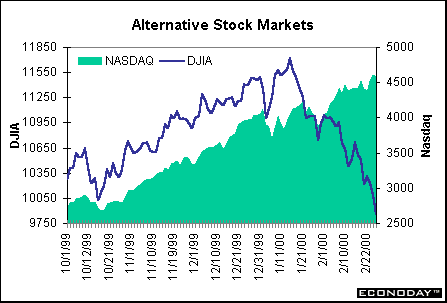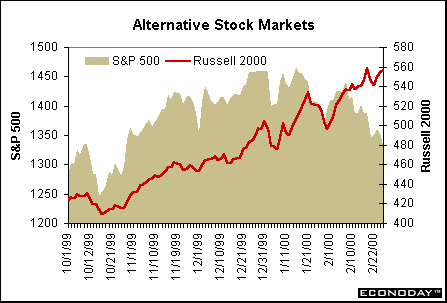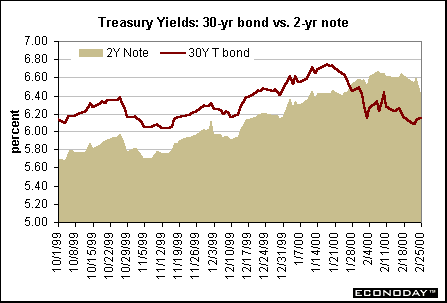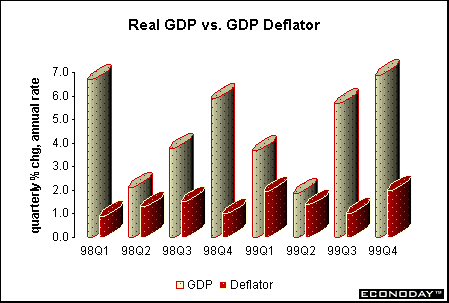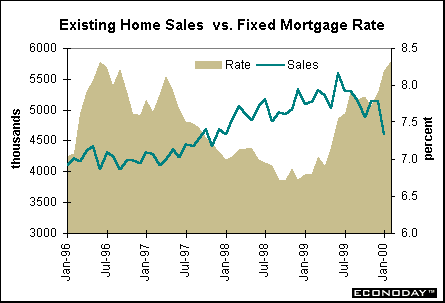| |||||||||||||||||||||||||||||||||||
| Previous Articles |
|
Greenspan
has his say, again Equity investors were not all that thrilled with Greenspan's remarks a week ago when he indicated that stock prices were going to have to rise on par with income growth - about 6 percent a year. That's a far cry from the long-term average growth rate of roughly 11 percent a year for equities. Investors in the industrial sector are taking Greenspan at his word. The initial Fed tightening that began last year didn't really sink in with investors at first. This year's rate hike, with the promise of more to come, is scaring investors in those cyclical and interest-sensitive industries. Investors in the technology market appear to be unconcerned. After all, how badly can even 50 or 75 basis points hurt the market when the returns in high tech stocks are out of this world?
The NASDAQ composite index rose 174.9 points this week and is 12.8 percent above year-end levels. The Russell 2000 -- the primary index of small-capitalization stocks - is rising as well, although at a slightly slower rate than the NASDAQ. The Russell is up 11.1 points this week, and 10.3 percent above year-end levels.
The Dow Jones Industrials plunged this week - and even managed to pass the psychological 10,000 mark, on the down side. This blue chip index is now 14.2 percent below year-end levels and stands at its lowest since April 1999. Interesting tidbit: In four of the past five Fridays, the Dow has fallen more than 200 points. The S&P 500 is laden with tech stocks, but that is not preventing the index from following the Dow Industrials on the lower track. The S&P 500 fell 13.4 points this week and is 9.3 percent lower than year-end. Treasury
market in a quandary
(BP = basis points; stock price indices are rounded) GDP
growth revised higher for Q4
Personal consumption expenditures grew at a 5.9 percent rate in the fourth quarter, surpassing the pace for the middle two quarters of the year, but not quite as robust as the January-to-March (1999) period. A spurt in durable goods spending helped propel the figure, but spending on nondurable goods was pretty healthy too. Business fixed investment moderated significantly during the quarter as declines in nonresidential structures partially offset modest gains in capital equipment and software. The recent uptick in nondefense capital goods orders suggests that this sector could see some acceleration of growth in the first half of 2000 Residential investment increased at an anemic 1 percent rate, offsetting only a small portion of the drop posted in the third quarter. There is no getting around the fact that housing activity hit a boil about mid-year 1999. Housing activity is still percolating at a high level, but is moderating. Higher mortgage rates have curtailed activity to some extent. Net exports deteriorated sharply in the fourth quarter, but less than the initial estimate showed. Exports grew at a 8.7 percent rate in the fourth quarter, continuing the trend set earlier this year of more pronounced quarterly gains. Imports grew at a 10 percent rate - healthy, but at a slower pace than earlier in the year. A surge in government expenditures in the fourth quarter rounded out this quarter. It is likely that Y2K provisions spurred the rise in federal defense and nondefense outlays. Analysts don't expect these kinds of increases to be sustained. The GDP deflator rose at a 2 percent rate in the fourth quarter, unchanged from the advance estimate. This growth is faster than the middle two quarters of the year, but largely reflects a spurt in energy prices. The PCE (personal consumption expenditure) deflator rose at a 2.5 percent rate - also unchanged from the initial report. This is the series Greenspan favors over the CPI since it reflects changes in the composition of spending as well as changes in prices. While the deflator accelerated from a quarter ago, the bulk of the gain came from higher energy prices. The bottom-line on growth? Getting worried about fourth quarter GDP growth seems silly as we end the month of February. After all, that was ages ago! Yet, the figures suggest strong momentum in economic activity that won't be stopped on a dime. That could mean that the Fed's tightening policy has only just begun. The data pretty much confirm what Greenspan mentioned at his recent Humphrey-Hawkins testimony. Inflation is not yet a problem. But the more growth exceeds its path, and the longer it does so, the greater the risks of inflation. Yes, fourth quarter GDP is old news, but it's not irrelevant to Fed officials. Housing
activity, first sign of cracking?
Whether the January level will be revised away next month isn't all that important. The chart below shows that sales have indeed moderated dramatically in the past several months - in tandem with rising mortgage rates. In February, the 30-year fixed mortgage rate stood at 8.33 percent - its highest level since mid-1996. Even if the decline in January home sales is overstated, the data does suggest that housing activity peaked last summer and is headed for a slowdown.
The bottom-line on housing? Existing home sales dropped sharply in January, but even if one is less inclined to believe that housing demand could have declined so precipitously in one month, there is no question that home sales peaked last summer. Higher mortgage rates are slowly but surely dampening demand. Eventually, this translates into slower retail sales as the need for new furniture and appliances diminishes. Fed officials are likely to be reassured by these figures - although it won't prevent the Fed from raising rates again at the March FOMC meeting. Durable
goods healthy despite January dip
The bottom-line on manufacturing activity? For the most part, industrial production and new orders were not enjoying the same robust pace of growth that was evident in the consumer sector in the first part of 1999. At the end of 1999, new orders picked up steam and this momentum will carry forward into 2000. These figures support stronger gains for industrial production. Until now, employment in the manufacturing sector was very soggy - posting monthly declines for more than one year. We haven't seen a real turnaround in factory payrolls yet. Federal Reserve officials may not be encouraged about the pick up in manufacturing activity - and could worry that this will increase labor demand further in one sector that previously saw declining labor demand. THE
BOTTOM LINE GDP news was old news but still revealed strong momentum going into this year. While the manufacturing sector is improving (durable goods orders), the housing market may be moderating as the impact of higher mortgage rates finally takes effect. Market players are going to become more skittish than ever in the next few weeks. Next week brings everyone's favorite indicator - the employment situation. It will set the tone for the month. But market players will get more nervous as we approach mid-month and the next FOMC meeting in which the Fed is likely to raise the fed funds target another 25 basis points. Looking
Ahead: Week of February 28 to March 3 Monday
Tuesday
The Chicago Purchasing Managers' Survey is expected to rise to 56.5 in February from a level of 55.6 in January. The Chicago index is widely followed because it tends to predict changes in the NAPM. Wednesday
The market consensus calls for a 0.4 percent gain in construction spending in January. Expenditures rose 2 percent in each of the previous two months. Thursday
The consensus shows that the Conference Board's index of leading indicators should edge up 0.3 percent in January after larger gains the previous few months. As long as the index continues to rise, it isn't signaling any signs of downturn. New home sales are predicted to decline 1.1 percent in January to an 890,000 unit rate. Often, new home sales and existing home sales move in the same direction, if not by the same magnitude. Existing home sales plunged nearly 11 percent in January. Friday
The market consensus shows that factory orders will decline 0.5 percent in January after December's robust gain of 3.3 percent. This reflects the smaller-than-expected drop in advance durable goods orders. |
||||||||||||||||||||||||||||||||||||||||||||||||||||||||||||||||||||||||||||||||||||||||||||||||||||||||



